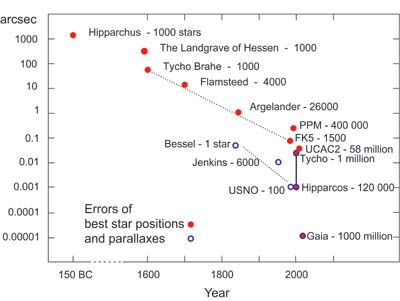[/caption]
Parallax is the apparent difference in the position (line of sight to) an object, when the object is viewed from different locations. So, when we observe that a star has apparently moved (not to be confused with it actually having moved – proper motion), when we look at it from two different locations on the Earth’s orbit around the Sun (i.e. on different dates), that’s stellar parallax! (And if the star does not seem to have moved? Well, its parallax is zero).
The furthest apart two locations on the Earth’s orbit can be is 2 au (two astronomical units), as when observations of an object are taken six months apart. By simple trigonometry (geometry), the distance to the object being observed is just the length of the baseline divided by the tangent of the parallax angle (the angular difference in the two lines of sight) … and since parallax angles are extremely small for stars (less than one arcsecond), the tangent of the angle is the same as the angle. This gives a natural unit of distance for stars, the parsec … which is the distance at which an object has a parallax of one arcsecond when viewed from a baseline of one au.
There was a pretty hot competition, among astronomers, to be the first to measure the parallax of a star (other than the Sun), back in the 1830s; the race was won by Friedrich Bessell (remember Bessell functions?), in 1838, with a measurement of the parallax of 61 Cygni (0.314 arcsecs, in case you were wondering; two other astronomers measured the parallax of different stars in the same year).
To date, the most accurate parallaxes (~1 milli-arcsec) are the 100,000 or so obtained by the ESA’s Hipparcos mission (which operated between 1989 and 1993; results published in 1997) … Hipparcos stands for High Precision Parallax Collecting Satellite, but is also a nod to the ancient Greek astronomer Hipparchus. The follow-up mission, Gaia (target launch date: 2012) will substantially improve on this (up to a billion stars, parallaxes as small as 20 micro-arcsec). Here’s a fun fact: Gaia will measure the gravitational deflection caused the Sun … across the whole sky (and detect that due to Mars, for stars near the line sight to it)!
Universe Today has several stories on, or featuring, stellar parallax; here are a few: New Stellar Neighbors Found, Chasing an Occultation, and Happy Birthday Johannes Kepler.
Distance in Space is an Astronomy Cast episode on this very topic!
References:
http://hyperphysics.phy-astr.gsu.edu/hbase/astro/para.html
http://starchild.gsfc.nasa.gov/docs/StarChild/questions/parallax.html

